Saltzman B. (editor) Anomalous Atmospheric Flows and Blocking
Подождите немного. Документ загружается.


This Page Intentionally Left Blank
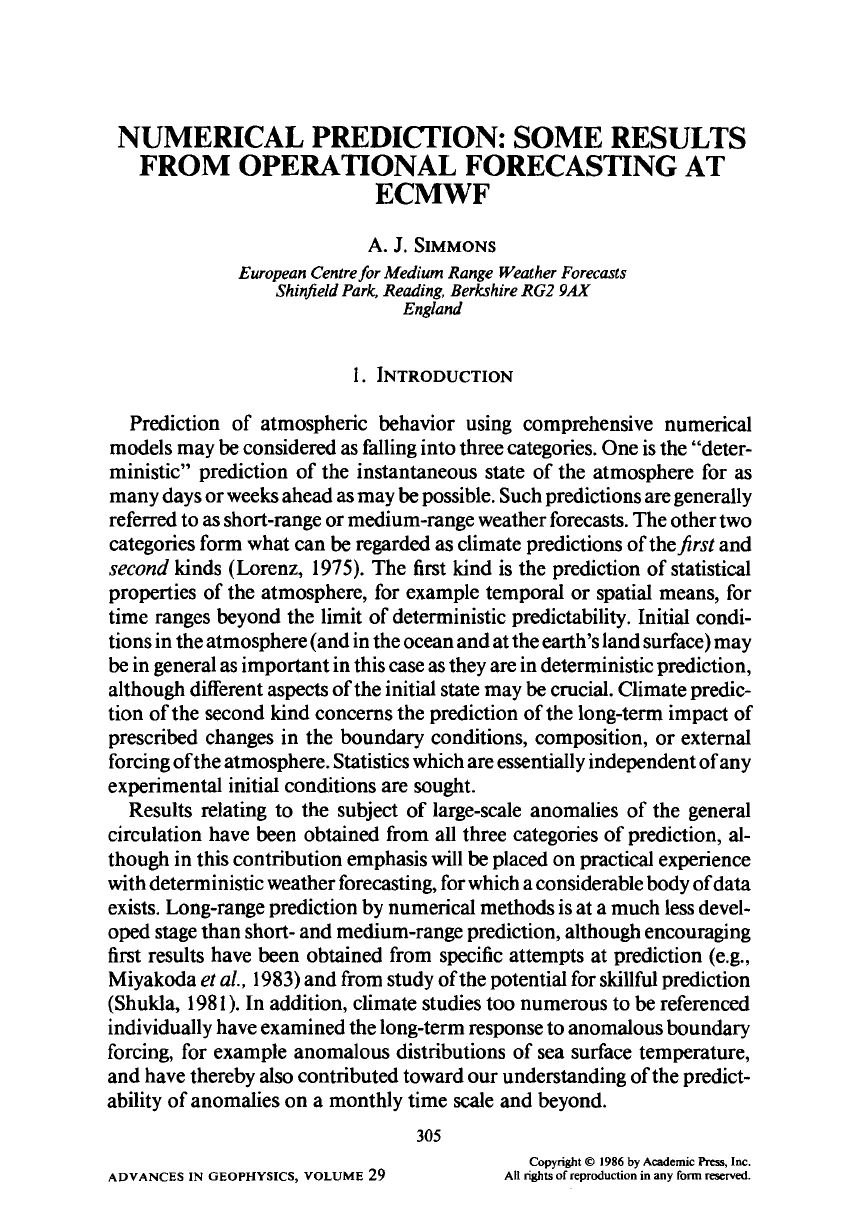
NUMERICAL PREDICTION: SOME RESULTS
FROM OPERATIONAL FORECASTING AT
ECMWF
A.
J.
SIMMONS
European Centre for Medium Range Weather Forecasts
Shinfield Park, Reading, Berkshire RG2
9AX
England
1.
INTRODUCTION
Prediction of atmospheric behavior using comprehensive numerical
models may be considered as falling into three categories. One is the “deter-
ministic” prediction of the instantaneous state of the atmosphere for
as
many days or weeks ahead
as
may
be
possible. Such predictions are generally
referred to
as
short-range or medium-range weather forecasts. The other two
categories form what can be regarded as climate predictions of thefirst and
second
kinds (Lorenz,
1975).
The first kind is the prediction of statistical
properties of the atmosphere, for example temporal or spatial means, for
time ranges beyond the limit
of
deterministic predictability. Initial condi-
tions in the atmosphere (and in the ocean and at the earth’s land surface) may
be in general
as
important in this case as they are in deterministic prediction,
although different aspects of the initial state may
be
crucial. Climate predic-
tion
of
the second kind concerns the prediction of the long-term impact of
prescribed changes in the boundary conditions, composition, or external
forcing
of
the atmosphere. Statistics which are essentially independent of any
experimental initial conditions are sought.
Results relating to the subject of large-scale anomalies of the general
circulation have been obtained from all three categories of prediction, al-
though in this contribution emphasis will
be
placed on practical experience
with deterministic weather forecasting, for which a considerable body ofdata
exists. Long-range prediction by numerical methods is at a much less devel-
oped stage than short- and medium-range prediction, although encouraging
first results have been obtained from specific attempts at prediction (e.g.,
Miyakoda
et
al.,
1983)
and from study of the potential for skillful prediction
(Shukla,
198
1).
In addition, climate studies too numerous to be referenced
individually have examined the long-term response to anomalous boundary
forcing, for example anomalous distributions of sea surface temperature,
and have thereby also contributed toward our understanding of the predict-
ability
of
anomalies on a monthly time scale and beyond.
305
Copyright
0
1986
by
Academic
Press,
Inc.
All
rights
of
reproduction
in
any
form
resewed.
ADVANCES
IN
GEOPHYSICS,
VOLUME
29
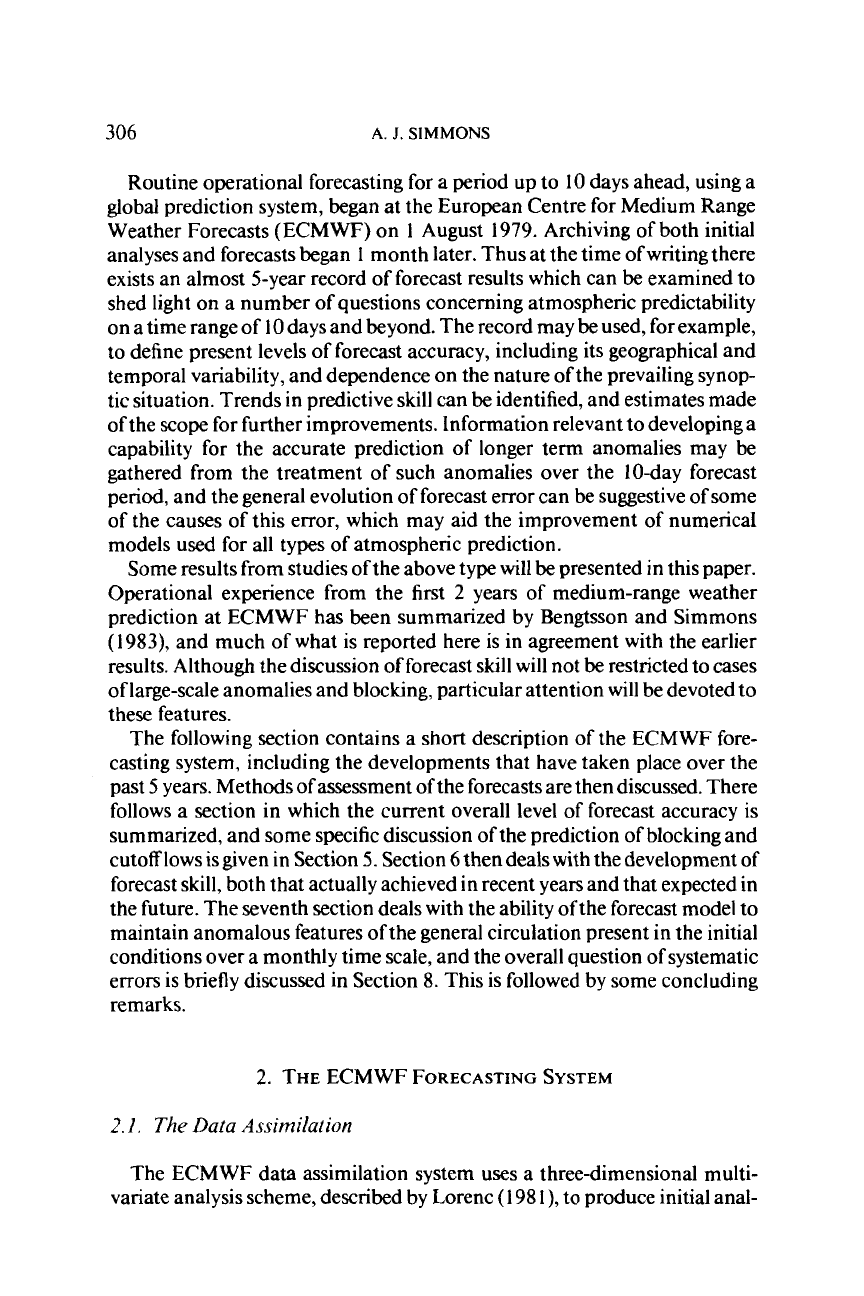
306
A.
J.
SIMMONS
Routine operational forecasting for a period up to
10
days ahead, using a
global prediction system, began at the European Centre for Medium Range
Weather Forecasts (ECMWF) on
1
August
1979.
Archiving of both initial
analyses and forecasts began
1
month later. Thus at the time ofwriting there
exists an almost 5-year record of forecast results which can be examined to
shed light on a number of questions concerning atmospheric predictability
on a time range
of
10
days and beyond. The record may
be
used, for example,
to define present levels
of
forecast accuracy, including its geographical and
temporal variability, and dependence on the nature of the prevailing synop-
tic situation. Trends in predictive skill can be identified, and estimates made
of the scope for further improvements. Information relevant
to
developing
a
capability for the accurate prediction of longer term anomalies may be
gathered from the treatment of such anomalies over the 10-day forecast
period, and the general evolution of forecast error can be suggestive of some
of the causes of this error, which may aid the improvement of numerical
models used for
all
types of atmospheric prediction.
Some results from studies ofthe above type
will
be presented in this paper.
Operational experience from the first
2
years
of
medium-range weather
prediction at ECMWF has been summarized
by
Bengtsson and Simmons
(1983),
and much of what
is
reported here is in agreement with the earlier
results. Although the discussion of forecast skill will not
be
restricted
to
cases
of large-scale anomalies and blocking, particular attention will be devoted to
these features.
The following section contains a
short
description of the
ECMWF
fore-
casting system, including the developments that have taken place over the
past
5
years. Methods of assessment of the forecasts are then discussed. There
follows a section in which the current overall level of forecast accuracy is
summarized, and some specific discussion of the prediction of blocking and
cutofflows
is
given in Section
5.
Section
6
then dealswith the development
of
forecast skill, both that actually achieved in recent yearsand that expected in
the future. The seventh section deals with the ability of the forecast model to
maintain anomalous features of the general circulation present in the initial
conditions over a monthly time scale, and the overall question of systematic
errors is briefly discussed in Section
8.
This is followed
by
some concluding
remarks.
2.
THE
ECMWF FORECASTING SYSTEM
2.1.
The
Data
Assimilation
The ECMWF data assimilation system uses a three-dimensional multi-
variate analysis scheme, described by Lorenc
(
198
I),
to produce initial anal-
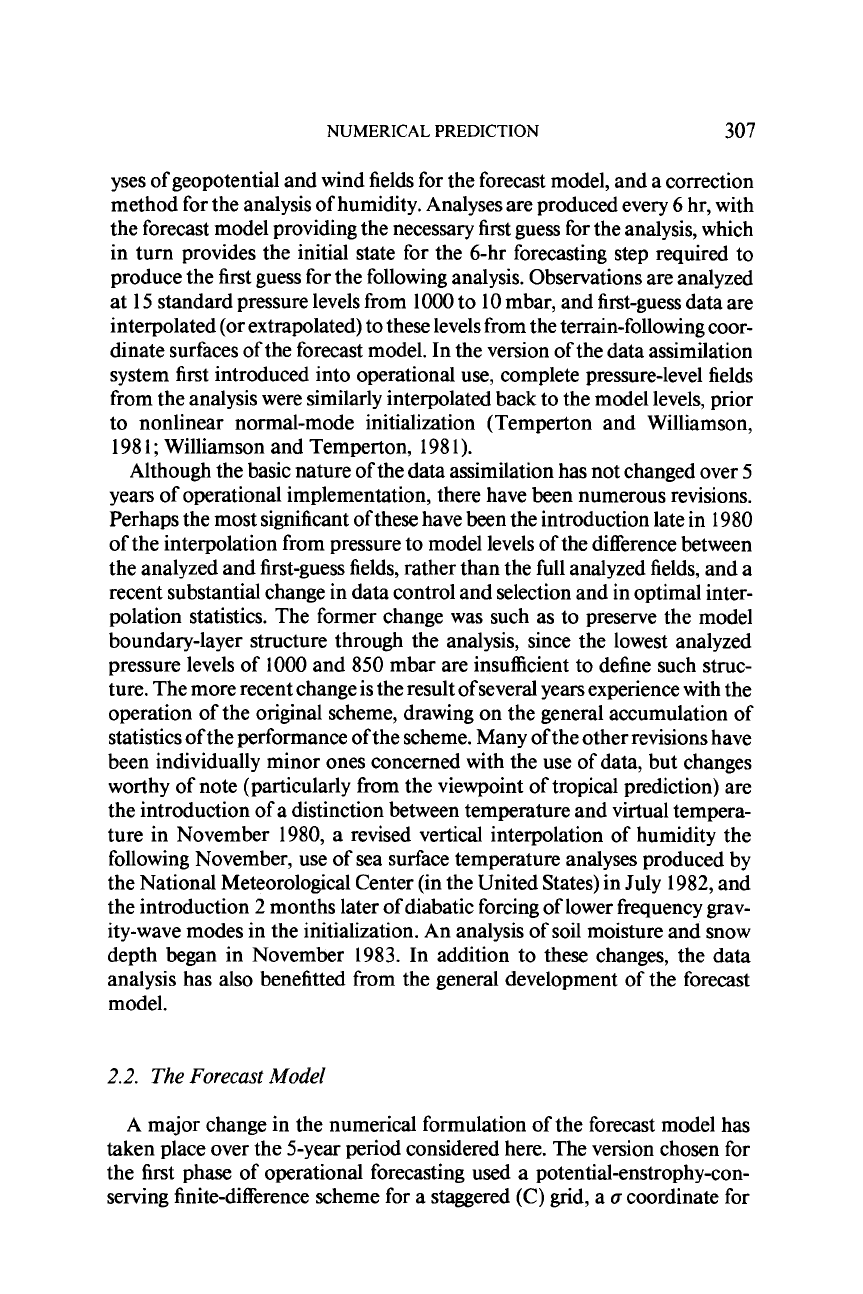
NUMERICAL
PREDICTION
307
yses of geopotential and wind fields for the forecast model, and a correction
method for the analysis of humidity. Analyses are produced every 6 hr, with
the forecast model providing the necessary first guess for the analysis, which
in turn provides the initial state for the 6-hr forecasting step required to
produce the first guess for the following analysis. Observations are analyzed
at
1
5 standard pressure levels from 1000 to
I0
mbar, and first-guess data are
interpolated (or extrapolated) to these levels from the terrain-following coor-
dinate surfaces of the forecast model. In the version of the data assimilation
system first introduced into operational use, complete pressure-level fields
from the analysis were similarly interpolated back to the model levels, prior
to nonlinear normal-mode initialization (Temperton and Williamson,
198
I
;
Williamson and Temperton, 198 1).
Although the basic nature of the data assimilation has not changed over 5
years of operational implementation, there have been numerous revisions.
Perhaps the most significant of these have been the introduction late in 1980
of the interpolation from pressure to model levels of the difference between
the analyzed and first-guess fields, rather than the full analyzed fields, and a
recent substantial change in data control and selection and in optimal inter-
polation statistics. The former change was such as to preserve the model
boundary-layer structure through the analysis, since the lowest analyzed
pressure levels of
1000
and 850 mbar are insufficient to define such struc-
ture. The more recent change is the result ofseveral years experience with the
operation of the original scheme, drawing on the general accumulation of
statistics of the performance of the scheme. Many of the other revisions have
been individually minor ones concerned with the use of data, but changes
worthy of note (particularly from the viewpoint of tropical prediction) are
the introduction of a distinction between temperature and virtual tempera-
ture in November 1980, a revised vertical interpolation of humidity the
following November, use of sea surface temperature analyses produced by
the National Meteorological Center (in the United States) in July 1982, and
the introduction 2 months later of diabatic forcing of lower frequency grav-
ity-wave modes in the initialization. An analysis of soil moisture and snow
depth began in November 1983. In addition to these changes, the data
analysis has also benefitted from the general development of the forecast
model.
2.2.
The
Forecast
Model
A
major change in the numerical formulation of the forecast model has
taken place over the 5-year period considered here. The version chosen for
the first phase of operational forecasting used a
potential-enstrophy-con-
serving finite-difference scheme for a staggered (C) grid, a
0
coordinate for
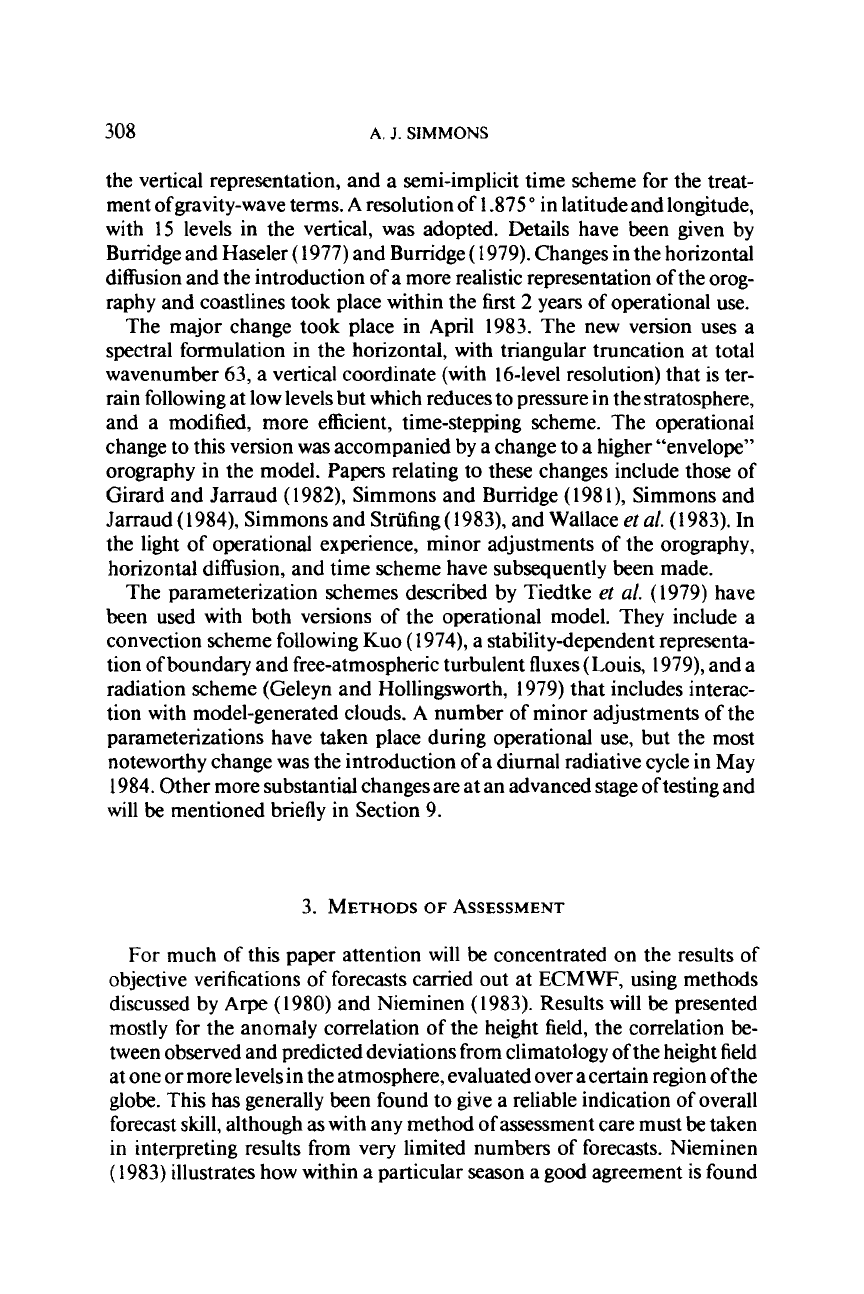
308
A.
J.
SIMMONS
the vertical representation, and a semi-implicit time scheme for the treat-
ment ofgravity-wave terms.
A
resolution of 1.875’ in latitude and longitude,
with 15 levels in the vertical, was adopted. Details have been given by
Burridge and Haseler
(
1977) and Burridge
(
1979). Changes in the horizontal
diffusion and the introduction of a more realistic representation of the orog-
raphy and coastlines took place within the first 2 years of operational use.
The major change took place in April 1983. The new version uses a
spectral formulation in the horizontal, with triangular truncation at total
wavenumber 63, a vertical coordinate (with 16-level resolution) that is ter-
rain following at low levels but which reduces to pressure in the stratosphere,
and a modified, more efficient, time-stepping scheme. The operational
change to this version was accompanied by a change to a higher “envelope”
orography in the model. Papers relating to these changes include those of
Girard and Jarraud (1982), Simmons and Burridge (1981), Simmons and
Jarraud
(
1984), Simmons and Striifing (1983), and Wallace
et
al.
(1983). In
the light of operational experience, minor adjustments of the orography,
horizontal diffusion, and time scheme have subsequently been made.
The parameterization schemes described by Tiedtke
et
al.
(1979) have
been used with both versions of the operational model. They include a
convection scheme following
Kuo
(
1974), a stability-dependent representa-
tion of boundary and free-atmospheric turbulent fluxes (Louis, 1979), and a
radiation scheme (Geleyn and Hollingsworth, 1979) that includes interac-
tion with model-generated clouds.
A
number of minor adjustments of the
parameterizations have taken place during operational
use,
but the most
noteworthy change was the introduction of
a
diurnal radiative cycle in May
1984. Other more substantial changes are at an advanced stage of testing and
will be mentioned briefly in Section 9.
3. METHODS
OF
ASSESSMENT
For
much of this paper attention will be concentrated on the results of
objective verifications of forecasts carried out at ECMWF, using methods
discussed by Arpe (1980) and Nieminen (1983). Results will be presented
mostly for the anomaly correlation of the height field, the correlation be-
tween observed and predicted deviations from climatology of the height field
at one or more levels in the atmosphere, evaluated over acertain region of the
globe.
This has generally been found to give a reliable indication of overall
forecast skill, although
as
with any method of assessment care must
be
taken
in
interpreting results from very limited numbers of forecasts. Nieminen
(
1983) illustrates how within
a
particular season a
good
agreement
is
found
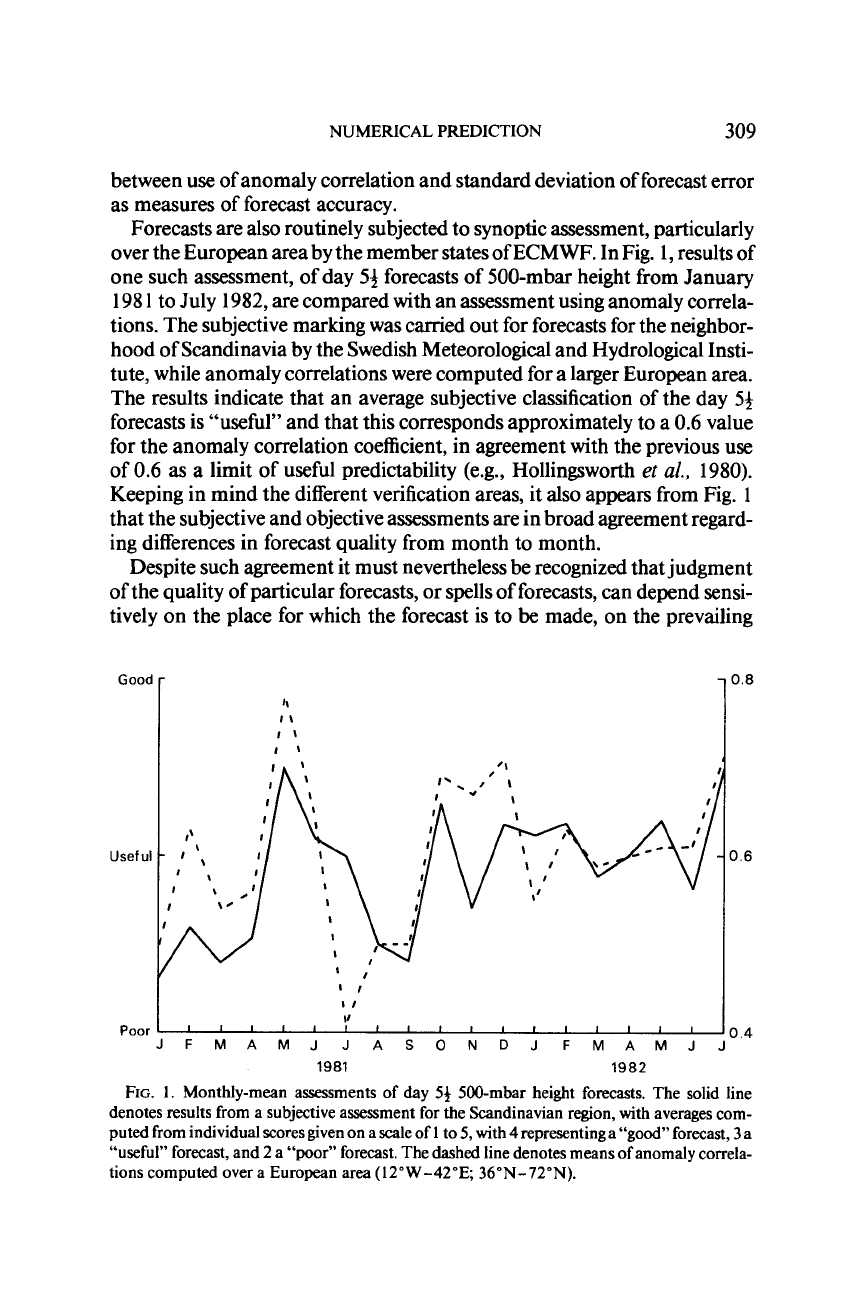
NUMERICAL PREDICTION
309
between use of anomaly correlation and standard deviation of forecast error
as measures of forecast accuracy.
Forecasts are also routinely subjected to synoptic assessment, particularly
over the European area by the member states of ECMWF. In Fig. 1, results of
one such assessment, of day
54
forecasts of 500-mbar height from January
198
1
to July 1982, are compared with an assessment using anomaly correla-
tions. The subjective marking was carried out for forecasts for the neighbor-
hood of Scandinavia by the Swedish Meteorological and Hydrological Insti-
tute, while anomaly correlations were computed for a larger European area.
The results indicate that an average subjective classification of the day
54
forecasts is “useful” and that this corresponds approximately to a
0.6
value
for the anomaly correlation coefficient, in agreement with the previous use
of
0.6
as
a
limit of useful predictability (e.g., Hollingsworth
et
al.,
1980).
Keeping in mind the different verification areas, it also appears from Fig.
1
that the subjective and objective assessments are in broad agreement regard-
ing differences in forecast quality from month to month.
Despite such agreement it must nevertheless be recognized that judgment
of
the quality of particular forecasts, or spells of forecasts, can depend sensi-
tively on the place for which the forecast is to
be
made, on the prevailing
1981 1982
FIG.
1.
Monthly-mean assessments of day
54
500-mbar height forecasts. The solid line
denotes results from a subjective assessment for the Scandinavian region, with averages com-
puted from individual scores given on a scale of
1
to
5,
with 4 representing a
‘‘god’
forecast, 3 a
“useful” forecast, and 2 a
“poor”
forecast. The dashed line denotes means of anomaly correla-
tions computed over a European area (12”W-42”E 36ON-72”N).
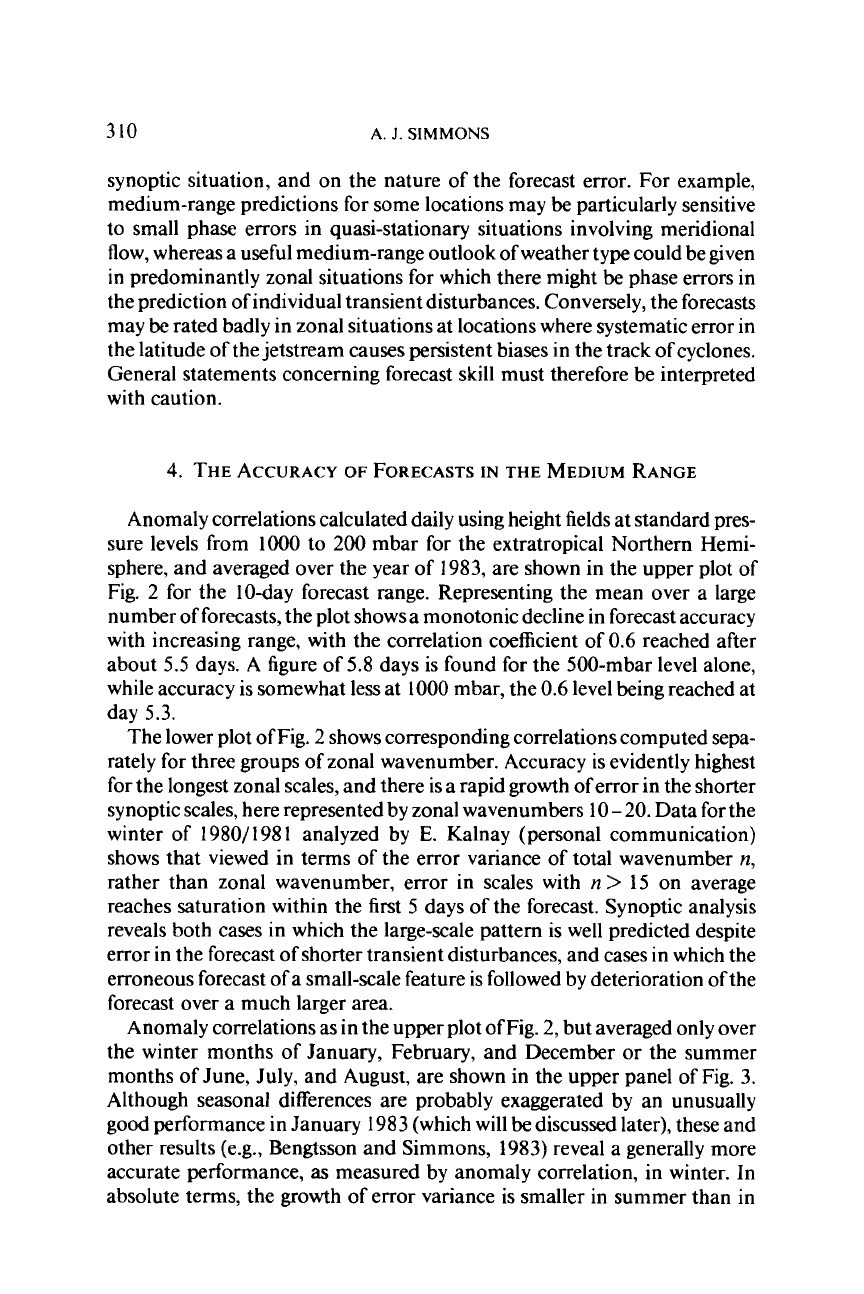
3
10
A.
J.
SIMMONS
synoptic situation, and on the nature of the forecast error. For example,
medium-range predictions for some locations may be particularly sensitive
to small phase errors in quasi-stationary situations involving meridional
flow, whereas a useful medium-range outlook ofweather type could be given
in
predominantly zonal situations for which there might be phase errors in
the prediction of individual transient disturbances. Conversely, the forecasts
may
be
rated badly in zonal situations at locations where systematic error in
the latitude of the jetstream causes persistent biases in the track of cyclones.
General statements concerning forecast skill must therefore be interpreted
with caution.
4.
THE
ACCURACY
OF
FORECASTS
IN
THE
MEDIUM
RANGE
Anomaly correlations calculated daily using height fields at standard pres-
sure levels from 1000 to
200
mbar for the extratropical Northern Hemi-
sphere, and averaged over the year of 1983, are shown in the upper plot of
Fig.
2
for the 10-day forecast range. Representing the mean over a large
number of forecasts, the plot shows a monotonic decline in forecast accuracy
with increasing range, with the correlation coefficient of
0.6
reached after
about
5.5
days.
A
figure of 5.8 days is found for the 500-mbar level alone,
while accuracy is somewhat less at
1000
mbar, the
0.6
level being reached at
day
5.3.
The lower plot of Fig.
2
shows corresponding correlations computed sepa-
rately for three groups of zonal wavenumber. Accuracy is evidently highest
for the longest zonal scales, and there is a rapid growth of error in the shorter
synoptic scales, here represented by zonal wavenumbers
10
-
20.
Data for the
winter of 1980/ 198
I
analyzed by
E.
Kalnay (personal communication)
shows that viewed in terms of the error variance of total wavenumber
n,
rather than zonal wavenumber, error in scales with
n
>
15
on average
reaches saturation within the first
5
days of the forecast. Synoptic analysis
reveals both cases in which the large-scale pattern is well predicted despite
error
in
the forecast of shorter transient disturbances, and cases in which the
erroneous forecast of a small-scale feature is followed by deterioration of the
forecast over a much larger area.
Anomaly correlations
as
in the upper plot of Fig.
2,
but averaged only over
the winter months of January, February, and December or the summer
months of June, July, and August, are shown in the upper panel of Fig.
3.
Although seasonal differences are probably exaggerated by an unusually
good performance in January 1983 (which will be discussed later), these and
other results (e.g., Bengtsson and Simmons, 1983) reveal a generally more
accurate performance,
as
measured by anomaly correlation, in winter.
In
absolute terms, the growth of error variance is smaller in summer than in
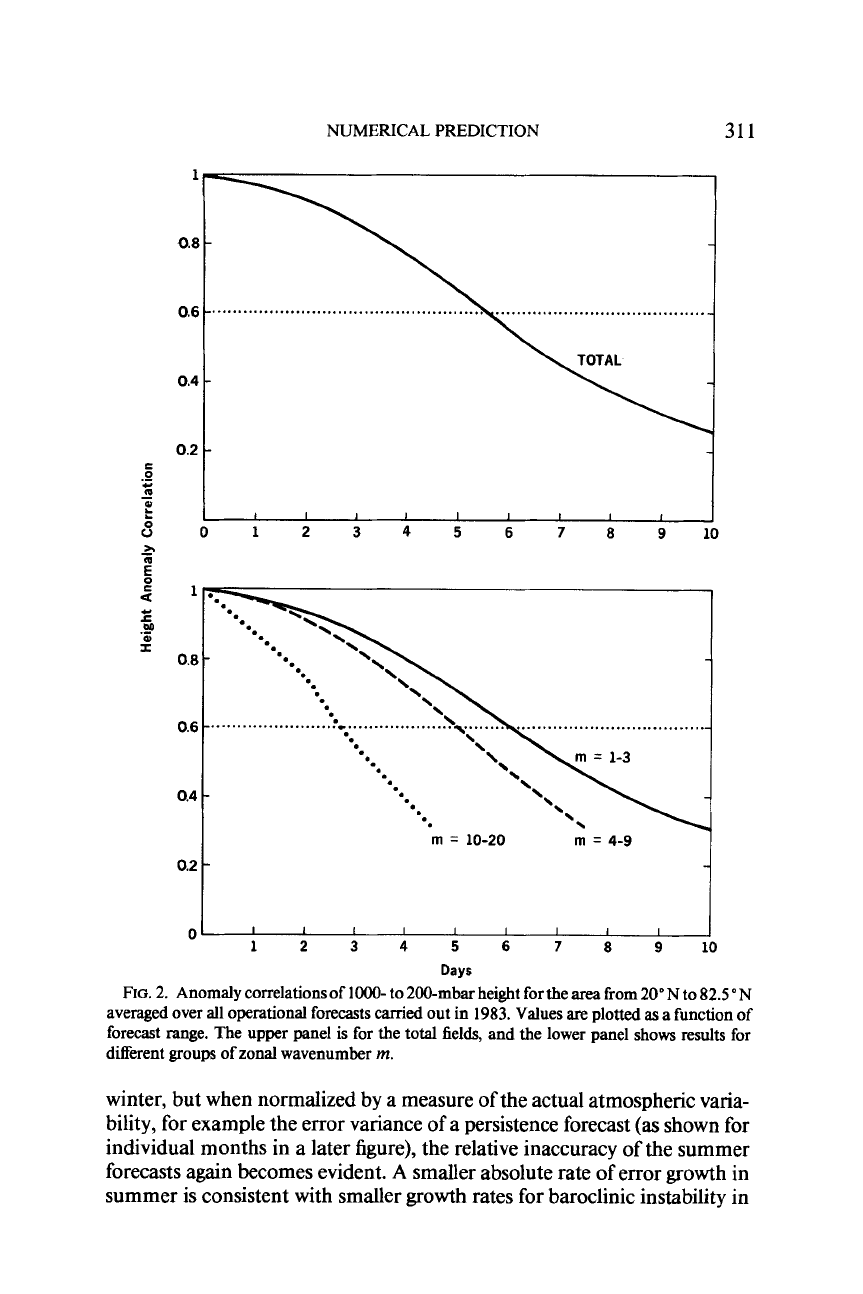
NUMERICAL PREDICTION
31
1
0.2
E
.-
.w
-
e
-
-
l
I
1
I
I
1
I
I
I
0.2
I
m
=
10-20
m
=
4-9
-
I
I
1
I
I
I
I
I
I
FIG.
2.
Anomaly correlations of
10oO-
to
200-mbar
height for the area from
20"N
to
82.5'
N
averaged over
all
operational forecasts carried out in
1983.
Values
are
plotted
as
a function of
forecast range. The upper panel is for the total fields, and the lower panel
shows
results for
different groups of zonal wavenumber
m.
winter, but when normalized by a measure of the actual atmospheric varia-
bility, for example the error variance of a persistence forecast
(as
shown for
individual months in a later figure), the relative inaccuracy of the summer
forecasts again becomes evident.
A
smaller absolute rate of error growth in
summer is consistent with smaller growth rates for baroclinic instability in
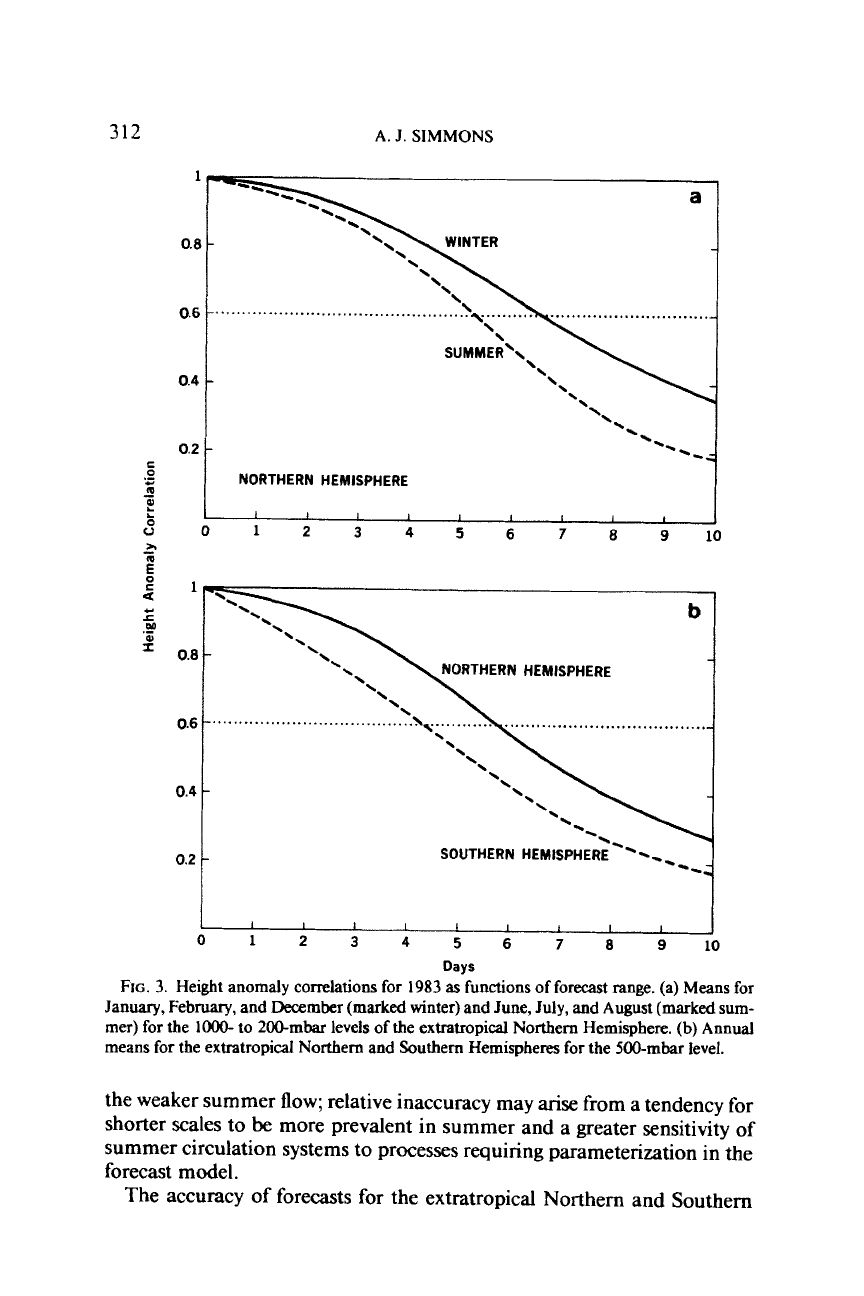
312
A.
J.
SIMMONS
0.2
-.
-
--
-
NORTHERN HEMISPHERE
L
L
I
I
I
I
I
I
I I
I
I
V
0
12
3
4
5
6
7
8
9
10
1
I
I
1
I
1
I
I
I
I
0
12
3
4
5
6
7
8
9
10
Days
FIG.
3.
Height anomaly correlations
for
1983
as
functions
of
forecast
range. (a) Means for
January, February, and December (marked winter) and June, July, and
August
(marked sum-
mer)
for
the
1OOO-
to
200-mbar levels
of
the extratropical Northern Hemisphere.
(b)
Annual
means
for
the
extratropical Northern and Southern Hemispheres
for
the 500-mbar level.
the weaker summer
flow;
relative inaccuracy may
arise
from a tendency for
shorter scales to
be
more prevalent in summer and a greater sensitivity
of
summer circulation systems to processes requiring parameterization in the
forecast model.
The accuracy of forecasts for the extratropical Northern and Southern
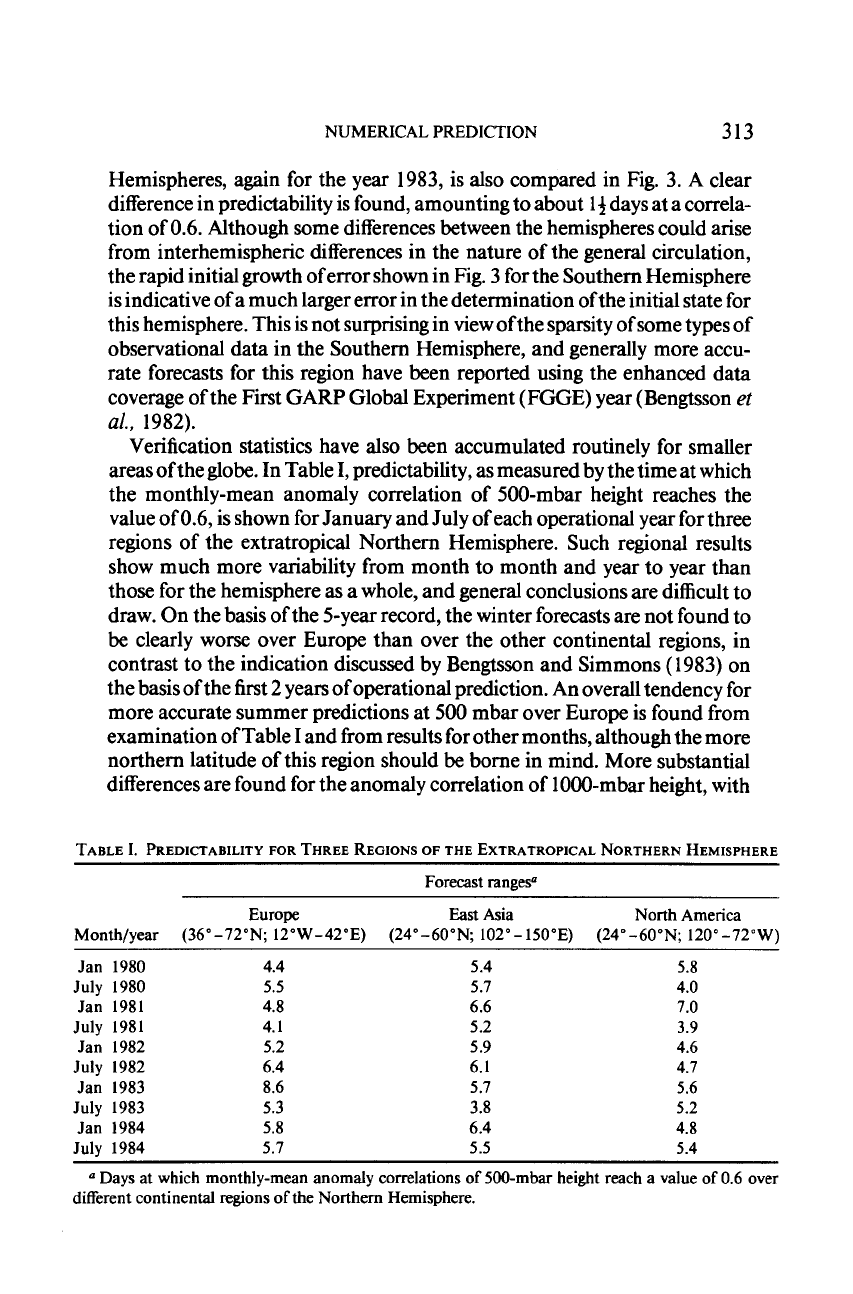
NUMERICAL PREDICTION
313
Hemispheres, again for the year
1983,
is also compared in Fig.
3.
A
clear
difference in predictability is found, amounting to about
I+
days at a correla-
tion of
0.6.
Although some differences between the hemispheres could arise
from interhemispheric differences in the nature of the general circulation,
the rapid initial growth oferror shown in Fig.
3
for the Southern Hemisphere
is indicative of a much larger error in the determination of the initial state for
this hemisphere. This is not surprising in view ofthe sparsity ofsome types of
observational data in the Southern Hemisphere, and generally more accu-
rate forecasts for this region have been reported using the enhanced data
coverage of the First GARP Global Experiment (FGGE) year (Bengtsson
et
al.,
1982).
Verification statistics have also been accumulated routinely for smaller
areas of the globe. In Table I, predictability, as measured by the time at which
the monthly-mean anomaly correlation of 500-mbar height reaches the
value of
0.6,
is shown for January and July of each operational year for three
regions of the extratropical Northern Hemisphere. Such regional results
show much more variability from month to month and year to year than
those for the hemisphere
as
a whole, and general conclusions are difficult to
draw. On the basis of the 5-year record, the winter forecasts are not found to
be
clearly worse over Europe than over the other continental regions, in
contrast to the indication discussed by Bengtsson and Simmons
(1983)
on
the basis of the first
2
years of operational prediction. An overall tendency for
more accurate summer predictions at
500
mbar over Europe is found from
examination of Table I and from results for other months, although the more
northern latitude of this region should be borne in mind. More substantial
differences are found for the anomaly correlation of 1000-mbar height, with
TABLE
1.
PREDICTABILITY
FOR
THREE REGIONS
OF
THE
EXTRATROPICAL NORTHERN HEMISPHERE
Forecast rangesa
Europe East Asia North America
Month/year
(36" -72"N; 12"W -42"E) (24" -60"N; 102"
-
150"E)
(24" -60"N; 120" -72
'
W)
Jan
1980 4.4 5.4 5.8
July
1980
5.5
5.7 4.0
Jan
1981 4.8 6.6 7.0
Jan
1982 5.2 5.9 4.6
Jan
1983 8.6 5.7 5.6
July
1983 5.3 3.8 5.2
Jan
1984 5.8 6.4 4.8
July
1984
5.1
5.5
5.4
July
1981 4.
I
5.2 3.9
July
1982 6.4 6.1 4.7
a
Days at which monthly-mean anomaly correlations
of
500-mbar height reach a value
of
0.6
over
different continental regions
of
the Northern Hemisphere.
